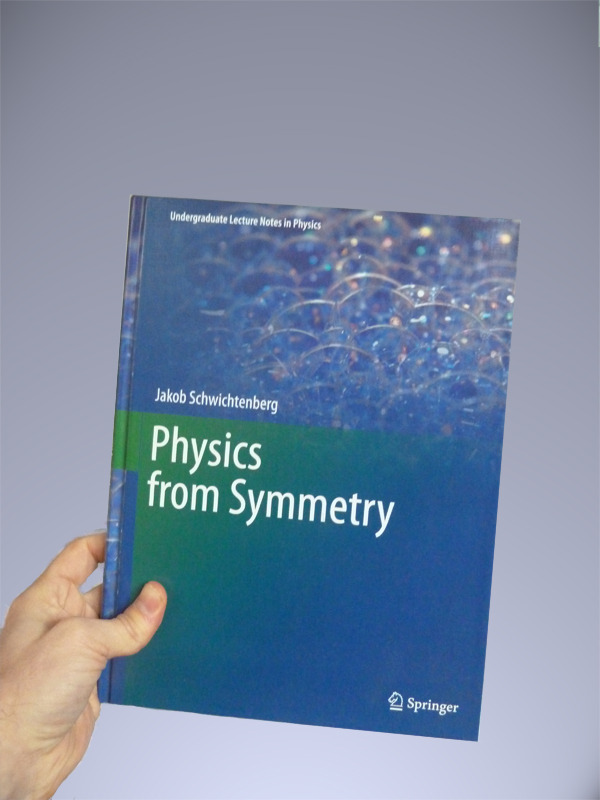 Update 10.4.16:
Update 10.4.16:
Almost one year after its publication it’s time for a small recap. On the downside, the book has made me neither rich nor famous so far ;). However there are some things that make me particularly happy:
- Rutwig Campoamor Stursberg has published a summary and review, in which he writes about Physics from Symmetry: “As a first contact text it is remarkably well written and motivated, and constitutes a very good preparation for the study of the hard formalism of more advanced books. […] Summarizing […] this book describes rather well the not always easy to understand subject of symmetry methods in physics, and will be a valuable addition to the bibliography for any interested reader, and even for the expert, with an alternative point of view.”
- Peter Rabinovitch has written a very positive review for the Mathematical Association of America.
- The reviews at Amazon.com are almost exlusively positive and include:
- “This book should be a must for every science and math undergraduate.“
- “Undergraduates, today and in the future, are so lucky to have this book. It’s the book I wish I had as an undergraduate, it would have saved a lot of time and misplaced effort.”
- “This is the book I’ve been looking for all these years. […] Overall, an excellent, almost magical, text covering all the major areas of physics in an accessible manner. Highly recommended!“
- “ A perfect Peskin preface“
- Similarly at Amazon.co.uk and Amazon.de:
- “A superb book. The future approach for undergraduate physics.”
- “Really helped me understand what was going on in my undergraduate degree. […] recommended for everyone to read”
- “Ausgesprochen zu empfehlen für alle Physikstudenten” (which translates to “Highly recommended for all students of physics“)
- Physics from Symmetry is among the recommended literature for the lecture “Symmetry Groups in Physics” at the university of Hamburg.
- I’ve received hundreds of emails from readers all around the world who reported errors, had questions or simply wanted to say that they liked the book. I enjoyed every single one of them, because it reminds me that people actually read what I’ve written. Always feel free to write me at mail |at| jakobschwichtenberg.com.
- There will be a German version of Physics from Symmetry by Springer Spektrum and the plan is that it gets published next year.
So, all in all the feedback has been overwhelmingly positive and I want to say thanks to everyone who took the time to write a few words!
After almost 18 month of hard work* my book has finally been published by Springer. Thanks to everyone who helped make the manuscript better and the team at Springer for their patience.
To learn more about the project have a look at the official homepage at PhysicsFromSymmetry.com.
The book is 279 pages long, costs around 49.99$ and is available as hardcover and pdf.
*Writing was fun but editing was … not so fun
Hi,
Can you please point me to the pdf version of your new book can be obtained?
Thank you,
Chris Johnson
Hey,
Sure, the pdf version is available at Springer:
http://www.springer.com/us/book/9783319192000
or
http://link.springer.com/book/10.1007%2F978-3-319-19201-7
Best wishes,
Jakob
Jakob:
At first, I want to thank you for writing this excellent book.
Secondly, I want to say something about the subsubchapter 3.7.8 The (1/2, 1/2) Representation of the book. Here we have a derivation of an element of the (1/2, 1/2) representation of SO(1,3). The derivation is nice along with the work of Matt Robinson’s book [note 142]. But I believe a more mathematically beautiful version of the derivation is available in the book named “Spinors in Physics” by Jean Hladik [page 145]. If you like it, then I think you can refer to it in the book too.
Waiting for more books from you,
Far
Hi Far,
Thanks for your comment and the book recommendation. I’ll have a look at Hladik’s book and include it in the second edition if I like it.
Best wishes,
Jakob
PS: If you haven’t already, writing a short review at Amazon would help me a lot, because good reviews mean that more people discover my book. Moreover, there is a Bonus Chapter for everyone who writes a review. See here.
Hi there, I would like to point out one apparent inconsistency in Eq. (3.172). In this equation, J_i = i K_i has been plugged in [from Eq. (3.170)].
But in Eq. (3.169), N_i^- & therefore J_i and K_i in Eq. (3.170) all are 1-dimensional matrices.
And in Eq. (3.172), N_i^+, J_i and K_i are 2-dimensioanl matrices.
Then how the plug in is justified?
Hi Ome,
The notation in Eq.(3.169) is a bit sloppy. N_i^- is not 1-dimensional, but a 2×2 matrix with only zeroes in it. This notation is similar to how one denotes the 2×2 unit matrix simply with a 1.
I hope this helps! Best wishes,
Jakob